![]() Many, many…many years ago, in a place called, “New Jersey”, I did a lot of pistol and rifle shooting at indoor ranges. The ammo I purchased and fired at the range, carried a light powder charge, a soft cast bullet and made clouds of acrid smoke and lead, in an environment mostly untouched by fresh or filtered air – clearly a simpler time. What I remember most of all, assuming I remember much of anything from that period, was that every hour of range time, typically resulted in two hours of bore scrubbing and lead removal effort, sometimes even involving the use of mercury as a lead absorbing substance. Consequently, I have had a life long dislike for bullets that are cast and, when cast bullets are infrequently mentioned on the Real Guns site, it is almost always in conjunction with some level of sarcasm, combined with a level of skepticism, and prefaced with a derogatory adjective.
Many, many…many years ago, in a place called, “New Jersey”, I did a lot of pistol and rifle shooting at indoor ranges. The ammo I purchased and fired at the range, carried a light powder charge, a soft cast bullet and made clouds of acrid smoke and lead, in an environment mostly untouched by fresh or filtered air – clearly a simpler time. What I remember most of all, assuming I remember much of anything from that period, was that every hour of range time, typically resulted in two hours of bore scrubbing and lead removal effort, sometimes even involving the use of mercury as a lead absorbing substance. Consequently, I have had a life long dislike for bullets that are cast and, when cast bullets are infrequently mentioned on the Real Guns site, it is almost always in conjunction with some level of sarcasm, combined with a level of skepticism, and prefaced with a derogatory adjective.
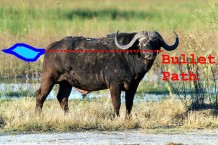 With the resurgence of old timer, big bore, revolver and rifle cartridges, the use of cast bullets is continually on the rise. There are the equipment manufacturers out there pitching, handloaders reporting astounding results and the cottage industry ammo makers with some relatively silly claims of their own. Apparently the .45-70, with a 500+ grain cast bullet, and trajectory that approximates the reciprocating arc of ’56 Chevy windshield wiper, is suitable for 200 yard shots at cape buffalo. In fact, not only can the bullet in these special loads make the arduous 200 yard journey but, on arrival, the bullet can fully transverse the 5,000 lb animal from nose to tail, then exit its buttocks in a brilliant blue flame. The night tracking benefit alone makes the use of this cartridge worthwhile.
With the resurgence of old timer, big bore, revolver and rifle cartridges, the use of cast bullets is continually on the rise. There are the equipment manufacturers out there pitching, handloaders reporting astounding results and the cottage industry ammo makers with some relatively silly claims of their own. Apparently the .45-70, with a 500+ grain cast bullet, and trajectory that approximates the reciprocating arc of ’56 Chevy windshield wiper, is suitable for 200 yard shots at cape buffalo. In fact, not only can the bullet in these special loads make the arduous 200 yard journey but, on arrival, the bullet can fully transverse the 5,000 lb animal from nose to tail, then exit its buttocks in a brilliant blue flame. The night tracking benefit alone makes the use of this cartridge worthwhile.
I like to hang on to old gun and equipment prejudices, and write only from that perspective; the approach is cost effective and a lot less work. This time, in regard to cast bullets, I thought I’d try for some first hand experience and see if I could gain some insight into what, apparently, everyone else already knows, and at least attempt making and shooting cast bullets.
Why? Why? Why?
The short answer is, I don’t know. Considering bullet casting has been around since the 14th century, and there is a ton of new equipment currently on the market, there must be many reasons why bullet casting is a viable pastime. I’d like to say cost savings is a leading factor, but I’d reserve offering this judgment until I’ve more closely examined all associated costs. Justification for casting bullets may be as basic as the sense of accomplishment derived from making your own bullets, and surely from using them on a successful hunt, or while participating in some form of competition.
I don’t know if the claims that cast bullets are superior to jacketed bullets for big game hunting are realistic. It appears perceptions vary, and seem to follow the philosophical debate of “small bore high velocity vs. big bore lower velocity”. I have seen a lot of appreciation for cast bullets in hunting applications expressed by .45 Long Colt and .50-Something shooters, but I haven’t heard much from the Ultra Mag crowd espousing the same; there is clearly a velocity cutoff for cast bullets. And as with jacketed bullets, there still seems to be a need to match velocity with alloy hardness, or BHN (Brinnell Hardness Number), which really isn’t much different than playing with jacket thickness and core density to accommodate various velocity levels and desired terminal ballistics.
Research and not so smooth beginnings
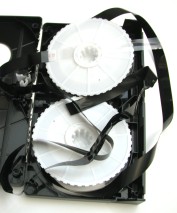
I like to begin any project, that involves an unfamiliar subject, with basic research. I even try to avoid asking questions of knowledgeable people until I know generally what to ask, and how to interpret the quality of the responses. I grabbed for my copy of the RCBS “Bullet Casting Video“, popped it into the VCR where it was promptly eaten, then called RCBS and ordered another copy. I thought I had already reviewed this tape, apparently not, so I wrote one when the new copy arrived. If you’re thinking about casting bullets, or just want to understand more about the process, this tape does a great job of connecting casting terminology to image, which is a great place to start. The production quality is excellent, the presentation is logical, informative while not overwhelming, and it leaves you with a good understanding of the fundamentals.
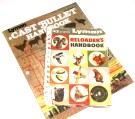 A 1960 copyright 42nd Edition Lyman Reloader’s Handbook served as a good indication of how things have changed over the years; 188 pages, which includes articles, muzzle loading firearms, cast bullets, popular rifle and handgun cartridge loads, a section on popular wildcats, and ballistic tables. By comparison, my current two volume Hornady reloading manual set is comprised of more than 1,400 pages. Of particular interest was the way #42 routinely posted cast bullet light loads for cartridges ranging from the .220 Swift through to the .375 H&H Magnum and .458 Winchester Magnum. This information actually offered an interesting perspective into the routine usefulness of cast bullets, which I’m sure is as valid today.
A 1960 copyright 42nd Edition Lyman Reloader’s Handbook served as a good indication of how things have changed over the years; 188 pages, which includes articles, muzzle loading firearms, cast bullets, popular rifle and handgun cartridge loads, a section on popular wildcats, and ballistic tables. By comparison, my current two volume Hornady reloading manual set is comprised of more than 1,400 pages. Of particular interest was the way #42 routinely posted cast bullet light loads for cartridges ranging from the .220 Swift through to the .375 H&H Magnum and .458 Winchester Magnum. This information actually offered an interesting perspective into the routine usefulness of cast bullets, which I’m sure is as valid today.
The November 1999 printing of Lyman’s “Cast Bullet Handbook“, 3rd edition was exceptionally useful in raising my level of understand of bullet casting. I think it is mandatory reading when coming at casting with little or no experience. Through the historical perspectives, current articles, tables, and explanations emerged a roadmap that provided early guidance for putting together a casting area and structuring an initial casting project. It was while reading through this handbook, I realized that much of the equipment I needed to purchase, would be defined by the cartridges that would be receiving the bullets I cast; molds, dies, equipment capacity all track to bullet size and type. I decided my initial selection would be one obvious choice, the .45-70 Government, and a maybe not so obvious choice, the .358-378 RG.
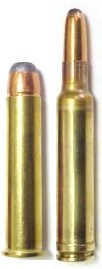 The .45-70 bullet selection is intended to address the issue of cost savings. Decent jacketed bullets are currently in the 35¢ to $50¢ range, really good bullets more than twice that amount. Cast bullet prices are the real shockers, and probably the reason there are so many companies producing this product. 3¢ worth of material and a low tech process, quickly becomes a 30¢ to 50¢ custom cast bullet.
The .45-70 bullet selection is intended to address the issue of cost savings. Decent jacketed bullets are currently in the 35¢ to $50¢ range, really good bullets more than twice that amount. Cast bullet prices are the real shockers, and probably the reason there are so many companies producing this product. 3¢ worth of material and a low tech process, quickly becomes a 30¢ to 50¢ custom cast bullet.
The .358-378RG cast bullet effort was based partially on cost; at 64¢ to $1.20 per quality jacketed bullet, cast could be much less expensive. However, going in, I pretty much knew cast loads would be inappropriate for anything other than drastically reduced load performance. I do think cast bullets might be the basis for an inexpensive light load that would allow me to use the gun more frequently for casual target shooting, and maybe even a little deer hunting. The inspiration for this type of cast bullet use was the old Lyman No. 42, which gave some good examples of cast bullet loads for even elephant thumper cartridges. Low pressure, moderately heavy bullets, and light recoil offer a potential for an interesting combination.
Initial Equipment Selection
I wanted to make a balanced, rather than expedient equipment selection, which means I avoided system buys, and took the opportunity to try equipment brands I wouldn’t ordinarily purchase. I placed my order with Lock Stock & Barrel in Valentine, Nebraska and, with the exceptions of one sizing die and one mould, they had everything else in stock. The shipment arrived 5 days later; well packed and exactly as requested. I ordered the remaining two items, a .458 sizing die and 300 grain .458 mould, directly from RCBS.
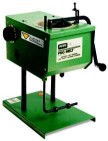 Furnaces are offered with a large variety of features, varying melting pot capacity, different temp control ranges and wattage ratings. Assembly quality is also vastly different amongst manufacturers, but not within one manufacturer. This is a place where you can spend lots of money, or a modest few dollars. The RCBS Pro-Melt Furnace is thermostatically controlled from 650º to 850º F, it can be set up for left or right hand operation, it has an 800 watt element and holds 22 lbs of lead. In theory, I could crank out over 500 bullets from a pot full of lead which, at the moment, is more than I need. The street price for a Pro-Melt is $235.
Furnaces are offered with a large variety of features, varying melting pot capacity, different temp control ranges and wattage ratings. Assembly quality is also vastly different amongst manufacturers, but not within one manufacturer. This is a place where you can spend lots of money, or a modest few dollars. The RCBS Pro-Melt Furnace is thermostatically controlled from 650º to 850º F, it can be set up for left or right hand operation, it has an 800 watt element and holds 22 lbs of lead. In theory, I could crank out over 500 bullets from a pot full of lead which, at the moment, is more than I need. The street price for a Pro-Melt is $235.
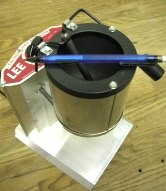 For $42 I was able to purchase a Lee Production Pot IV. The unit has 4 inches of clearance under the spout, an unobstructed view of mould filling, a 500 watt heating element, and a 10 lb melting pot capacity. I’m sure I couldn’t really equate this unit with the Pro-Melt in terms of quality and capability, but if my casting interests wane, $42 at the bottom of the closet collecting dust would feel only 18% as bad as if I had started out with the RCBS Pro-Melt. The unit is small; that’s a blue pencil sitting on top of it. Maybe, one day I’ll get a big boys furnace, but for now this beats melting lead, in a pot, on the stove.
For $42 I was able to purchase a Lee Production Pot IV. The unit has 4 inches of clearance under the spout, an unobstructed view of mould filling, a 500 watt heating element, and a 10 lb melting pot capacity. I’m sure I couldn’t really equate this unit with the Pro-Melt in terms of quality and capability, but if my casting interests wane, $42 at the bottom of the closet collecting dust would feel only 18% as bad as if I had started out with the RCBS Pro-Melt. The unit is small; that’s a blue pencil sitting on top of it. Maybe, one day I’ll get a big boys furnace, but for now this beats melting lead, in a pot, on the stove.
There are lots of alternatives to the products I’ve mentioned. Lyman and Lee have other models for as little as $28, Magma Engineering offers 40 lb capacity production equipment, which I’m sure covers the other end of the price and production spectrum. If anything seems of real consequence in the selection criteria, it’s buying a furnace that will have capacity to match your intended bullet casting activity, enough quality to support that level of production and the ability to fill moulds from the bottom of the pot. Going light on heating element wattage may mean the unit will have a difficult time holding a stable temperature when exposed to slight temperature changes, or it won’t adjust properly as lead levels vary in the melting pot.
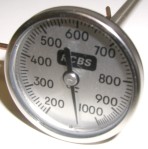
Years ago, I worked with a guy who stuck his fingers in a 700ºF wave solder flow because, he said, it was shiny and somewhat hypnotic. Fortunately, RCBS includes a wire thermometer safety handle to keep the user’s hands away from hot lead and, hopefully, a case of finger wading temptation. $32.95 for both.
I’ve seen thermometers referred as an optional accessory – not really, it’s necessary. Melting pot settings are somewhat relative, at least the inexpensive types I looked at, so they have no integrated circuitry to allow absolute thermostatic control. A thermometer will assure accurate temperature settings, allow monitoring and insure repeatability from session to session. There are some less expensive units on the market, but since temperature appears to be critical to the process, this didn’t seem like a good place to cut corners.
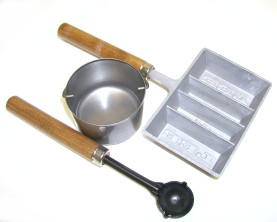
There are a few other tools that are also a part of casting life. To put the items at the right in context of scale, the cup of the ladle is 1.5″ in diameter and the ingot mold is 5″ wide. These are not giant utensils but they are, more importantly, correctly proportional to the size of the melting pot.
The ladle is used to stir the contents of the furnace when required, and could be, but won’t be, used for mould filling. The ingot mold is used to catch lead flow spill over and scrap from moulding, and makes useful 1/2 and 1 pound ingots from this and other reclaimed lead. The lead pot is a steel extrusion, rather than aluminum like the ingot mold or cast iron like most other brands, and may be used for melting lead over a heat source. At the moment I can think of no practical use, but they always seemed to be shown with an ingot mold. At the risk of angering Lee equipment fans, there is a good reason why these tools sell for much less than RCBS tools, they are quite cheesy. This doesn’t make them any less functional, but clearly not as durable. About $17 in total, for my purposes they’ll work just fine.
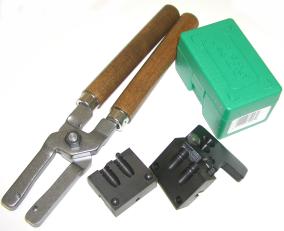
There are lots of moulds out there, from a variety of companies, at an assortment of prices, made principally from cast iron or aluminum – even though some moulds are listed under exotic descriptions (i.e. “copper alloyed pearlitic cast iron”, “Meehanite”). Molds utilize steel pins, plus bushings with aluminum, to insure alignment of the mould halves. Iron moulds must be protected from corrosion, oxidized moulding surfaces will result in funky bullets.
The principal benefit of aluminum is cost; as an example, street price for an aluminum Lee mould for the .45-70 was $13, the same from RCBS in cast iron was $50, SAECO (Redding) was $62 also in iron. NEI Handtools offers aluminum and iron versions of their moulds; $75 for the former, $100 for the latter. Other positive aspects of aluminum molds are; they don’t rust and they reach working temperature quickly. The mould handles, actually handles and handle clamps, run about $25 and can be transferred from one mould to another, within one brand at least, so they are not a one-for-one purchase. I went with iron RCBS moulds, which also got me the nifty green mould case.
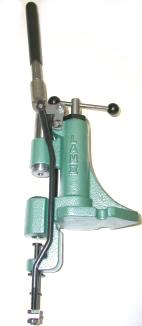 After bullets are cast, they may be subjected to several other steps. As an example, they may be sized to a more specific diameter, up to several thousandths of an inch smaller than as cast. The RCBS Lub-A-Matic-2 is a cast bullet sizer/lubricator. In addition to swaging the bullet to size, it also lubricates the bullet from a reservoir that is integrated into the press, but it will also permanently affix gas checks to the heal of the bullet.
After bullets are cast, they may be subjected to several other steps. As an example, they may be sized to a more specific diameter, up to several thousandths of an inch smaller than as cast. The RCBS Lub-A-Matic-2 is a cast bullet sizer/lubricator. In addition to swaging the bullet to size, it also lubricates the bullet from a reservoir that is integrated into the press, but it will also permanently affix gas checks to the heal of the bullet.
Cast led bullets, unprotected by a jacket, are easily melted and pressure formed. Gases from cartridges loaded to high pressures can burn through the round driving bands of cast bullets, causing loss of velocity and inaccuracy. Gas checks. small metal cups, seal the bullet from gas pressure and permit cast bullets to be driven to a higher velocity while reducing bore leading.
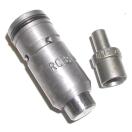
The items to the left are the sizer die and the smaller top punch. In operation, the two combine to keep the raw cast bullet in perfect alignment while it is swaged to size, packed with lubricant and a gas check is crimped to the heel of the bullet. Moulds are typically listed with matching sizer dies, top punch and bullet seating plugs. The approach makes selection for the novice, me, a lot easier.
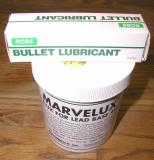
There is a lot of other…stuff I still don’t quite have a handle on. When lead alloy is melted at around 650ºF to 700ºF, a gray film will form on the surface. This film is comprised mostly of tin and needs to be recombined with the molten lead and antimony alloy. Flux is added to the pot to recombine all of these elements. I selected Marvelux, a dry flux, because it is suppose to be no fuming, which is always nice in a tight work area. Substances such as beeswax, paraffin and some types of bullet lube may alternatively be used.
There are also lots of kinds of bullet lubes, some to fit different applications, some to fit different biases, some the result of marketing programs. Then there is lead, from a variety of sources, in a variety of forms and compositions. Which all takes me to the conclusion of this segment and begins the next. Hopefully I’ll return with some actual cast bullets and loaded ammunition.
Oh, one more note before I move on – Every piece of equipment I purchased, even the handles, note the hazardous nature of lead. It isn’t necessary to take these cautions seriously, unless you dislike lose of memory and/or growing a third eye. Hobby casting, and even industrial lead casting, is safe when safety precautions are taken, rather than risks. Even just the handling of lead bullets requires the use of a modest amount of care. I will use recommended equipment in all phases and, if I were going to cast bullets on a regular basis, I would probably install a more permanent air exhaust – filtration system.
More “Casting bullets and selecting fire extinguishers”:
Casting bullets and selecting fire extinguishers Part I
Casting bullets and selecting fire extinguishers Part II
Casting bullets and selecting fire extinguishers Part III
Casting bullets and selecting fire extinguishers – Conclusion
Thanks
Joe

Email Notification